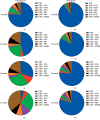Safety and Efficacy Evaluation of Traditional Chinese Medicine (Qingre-Lishi-Yishen Formula) Based on Treatment of Regular Glucocorticoid Combined with Cyclophosphamide Pulse in Children Suffered from Moderately Severe Henoch-Schonlein Purpura Nephritis with Nephrotic Proteinuria
- PMID: 32047523
- PMCID: PMC7007748
- DOI: 10.1155/2020/3920735
Safety and Efficacy Evaluation of Traditional Chinese Medicine (Qingre-Lishi-Yishen Formula) Based on Treatment of Regular Glucocorticoid Combined with Cyclophosphamide Pulse in Children Suffered from Moderately Severe Henoch-Schonlein Purpura Nephritis with Nephrotic Proteinuria
Abstract
Objective: At present, the most appropriate management of Henoch-Schonlein purpura nephritis (HSPN) with nephrotic-range proteinuria still remains controversial; thus, the purpose of this study is to evaluate safety and efficacy of traditional Chinese medicine (TCM), Qingre-Lishi-Yishen Formula (QLYF), integrated with regular oral glucocorticoid and cyclophosphamide intravenous pulse therapeutic regimen in children suffered from moderately severe HSPN with nephrotic proteinuria.
Methods: From 1 January 2012, to 1 January 2016, totally 150 hospitalized children suffered from HSPN with nephrotic proteinuria were included. All were treated with glucocorticoid and cyclophosphamide, and 100 of them were treated with integrative traditional Chinese decoction QLYF. Patients were followed up for 2 years. Rate of adverse event occurrence, short-term clinical effects, long-term clinical effects, and TCM therapeutic evaluation were all compared.
Results: Total adverse event rate was lower in the QLYF group (χ 2 = 5.357, p = 0.022); rates of respiratory infection, urinary infection, poor appetite, hepatotoxity, cardiotoxicity, and neutropenia were all decreased in patients who received QLYF (p = 0.022); rates of respiratory infection, urinary infection, poor appetite, hepatotoxity, cardiotoxicity, and neutropenia were all decreased in patients who received QLYF (p = 0.022); rates of respiratory infection, urinary infection, poor appetite, hepatotoxity, cardiotoxicity, and neutropenia were all decreased in patients who received QLYF (p = 0.022); rates of respiratory infection, urinary infection, poor appetite, hepatotoxity, cardiotoxicity, and neutropenia were all decreased in patients who received QLYF (p = 0.022); rates of respiratory infection, urinary infection, poor appetite, hepatotoxity, cardiotoxicity, and neutropenia were all decreased in patients who received QLYF (p = 0.022); rates of respiratory infection, urinary infection, poor appetite, hepatotoxity, cardiotoxicity, and neutropenia were all decreased in patients who received QLYF (.
Conclusion: Compared with merely using regular oral glucocorticoid plus cyclophosphamide pulse therapeutic regimen, the therapeutic regimen that integrates QLYF with the abovementioned western medicine might be a safe means to decrease the occurrence rate of adverse events and improve short-term and long-term clinical effects in children who suffered from moderately severe HSPN with nephrotic proteinuria.
Copyright © 2020 Lirong Fan et al.
Conflict of interest statement
The authors declare that there are no conflicts of interest regarding the publication of this paper.
Figures


References
LinkOut - more resources
Full Text Sources

